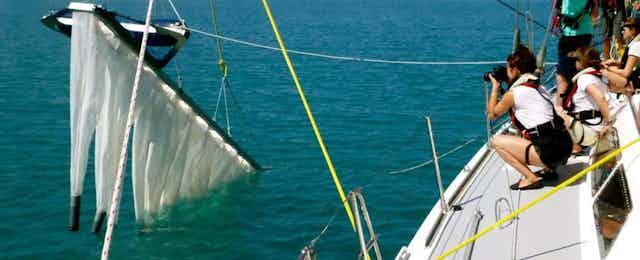The world’s ocean contains trillions of plastic fragments coming from packaging, fishing gear and other synthetic objects that break down at sea over time.
Most of what is known about these ocean plastics comes from surface net sampling, where the top 15cm of water is filtered to collect particles larger than 0.3mm.
Now we have published the first ever high-resolution depth profiles of ocean plastics in the journal Biogeosciences and data repository Figshare.
Most of the submerged plastics were very small – less than 1 mm across. Previous studies had noticed that tiny plastics were missing from the oceans.
We show that at least a fraction of this missing plastic is still adrift at sea, but at depths greater than the surface layer that is usually sampled by scientists.
A better characterisation of the vertical distribution of marine plastic pollution will improve predictions of plastic loads, particle sizes, and ecological impacts in the world’s oceans.
Vertical distribution of buoyant plastics
Buoyant plastics can be pushed underwater by the turbulence created by wind and waves. Models predict that the number of plastic particles decreases abruptly over the first few meters of the water column. However, until now, no subsurface measurements existed to test this prediction.
We developed a new device that collects samples from the sea surface at 50cm intervals, down to a depth of 5 meters. This device was used to sample one of the world’s major plastic pollution hotspots: the North Atlantic “garbage patch”.

Buoyant plastics were concentrated at the sea surface, with both numerical and mass concentrations decreasing exponentially with water depth. Nevertheless, under stronger winds this decrease was less abrupt. Our results match relatively well with those predicted by scientific models.

Look below the sea surface

The speed in which buoyant plastics return to the sea surface after being pushed into deeper waters by turbulence is an important parameter for predicting the depth profiles of marine plastic pollution. We found that smaller plastics present lower rising speeds, being therefore more susceptible to transport into deeper layers.
Even under light wind conditions, many of the tiniest plastics were still hidden underwater. This indicates that previous studies using surface-only samples are biased towards larger plastic pieces.
Two major studies last year headed by ocean scientists Andres Cózar and Marcus Eriksen both concluded that there are major losses of small plastics from oceans. We show that at least a fraction of this “missing” plastic is just under the sea surface.
More at-sea and experimental work is required to further quantify this effect and develop models capable of estimating depth-integrated size distribution of buoyant plastics drifting at sea.
What’s next?
Samples of ocean plastics from below the surface are still very scarce. Further multi-level sampling is extremely important to help us estimate how much plastic is actually in our oceans, and understand its ecological impacts.
Knowing how deep plastics go will help determine the chance of animals inhabiting different depths to encounter and interact with plastic items. For instance, sea birds, turtles, and mammals, which breathe air and use the sea surface for daily activities, present high rates of plastic ingestion and entanglement.

Ocean plastics are also enhancing ocean drift opportunities and causing damage to biota and habitats. Plastic items harbour organisms such as microbes, invertebrates and fish, which can disperse across oceans and potentially invade non-native habitats.
We emphasise that estimates on the amounts and impacts of plastic pollution across the oceans, both in coastal and oceanic environments, are urgently required. Such research is crucial to better inform those aiming to reduce the flow of plastics entering this environment, and develop mitigation strategies for this worldwide problem.

